Abstract
A large number of phthalate esters were screened for estrogenic activity using a recombinant yeast screen. a selection of these was also tested for mitogenic effect on estrogen-responsive human breast cancer cells. A small number of the commercially available phthalates tested showed extremely weak estrogenic activity. The relative potencies of these descended in the order butyl benzyl phthalate (BBP) > dibutyl phthalate (DBP) > diisobutyl phthalate (DIBP) > diethyl phthalate (DEP) > diisiononyl phthalate (DINP). Potencies ranged from approximately 1 x 10(6) to 5 x 10(7) times less than 17beta-estradiol. The phthalates that were estrogenic in the yeast screen were also mitogenic on the human breast cancer cells. Di(2-ethylhexyl) phthalate (DEHP) showed no estrogenic activity in these in vitro assays. A number of metabolites were tested, including mono-butyl phthalate, mono-benzyl phthalate, mono-ethylhexyl phthalate, mon-n-octyl phthalate; all were wound to be inactive. One of the phthalates, ditridecyl phthalate (DTDP), produced inconsistent results; one sample was weakly estrogenic, whereas another, obtained from a different source, was inactive. analysis by gel chromatography-mass spectometry showed that the preparation exhibiting estrogenic activity contained 0.5% of the ortho-isomer of bisphenol A. It is likely that the presence of this antioxidant in the phthalate standard was responsible for the generation of a dose-response curve--which was not observed with an alternative sample that had not been supplemented with o,p'-bisphenol A--in the yeast screen; hence, DTDP is probably not weakly estrogenic. The activities of simple mixtures of BBP, DBP, and 17beta-estradiol were assessed in the yeast screen. No synergism was observed, although the activities of the mixtures were approximately additive. In summary, a small number of phthalates are weakly estrogenic in vitro. No data has yet been published on whether these are also estrogenic in vitro. No data has yet been published on whether these are also estrogenic in vivo; this will require tests using different classes of vertebrates and different routes of exposure.
Full text
PDF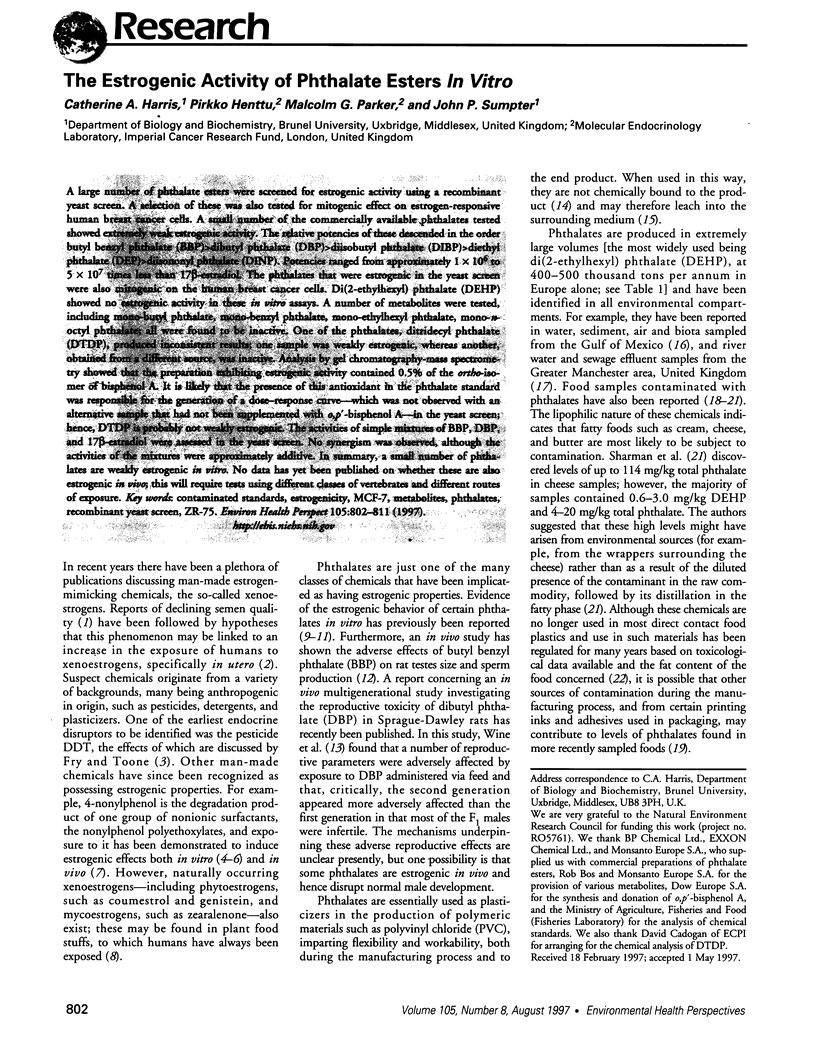
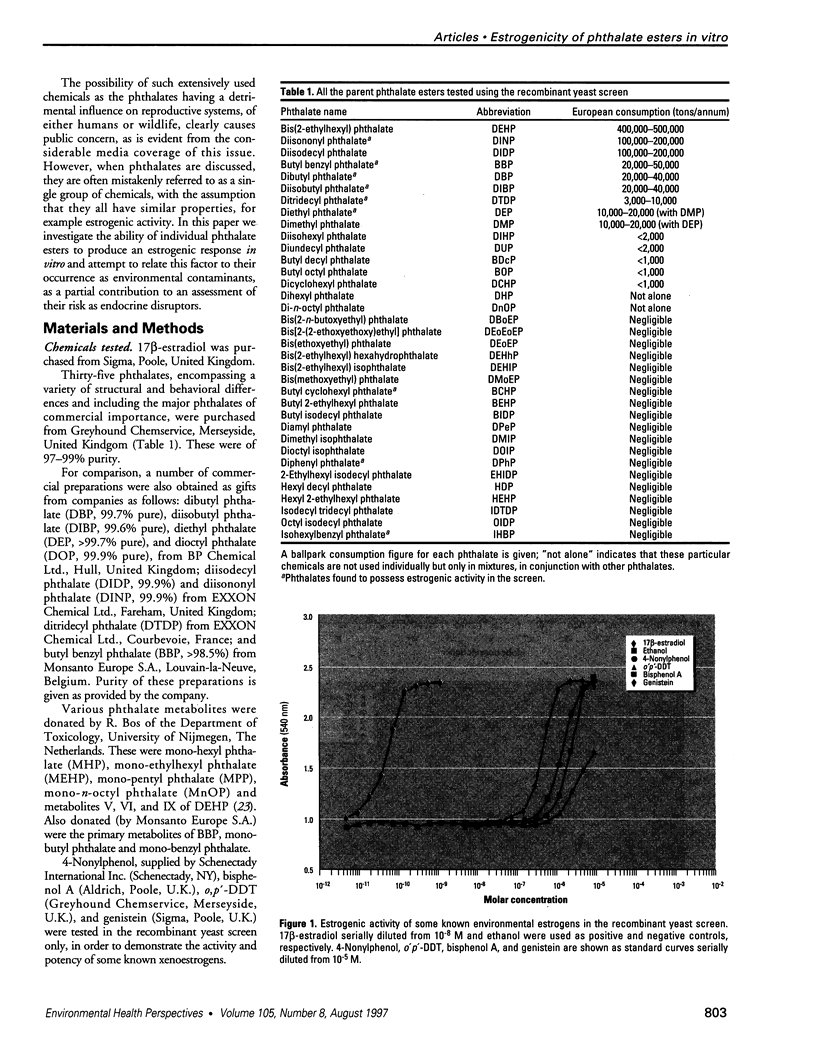
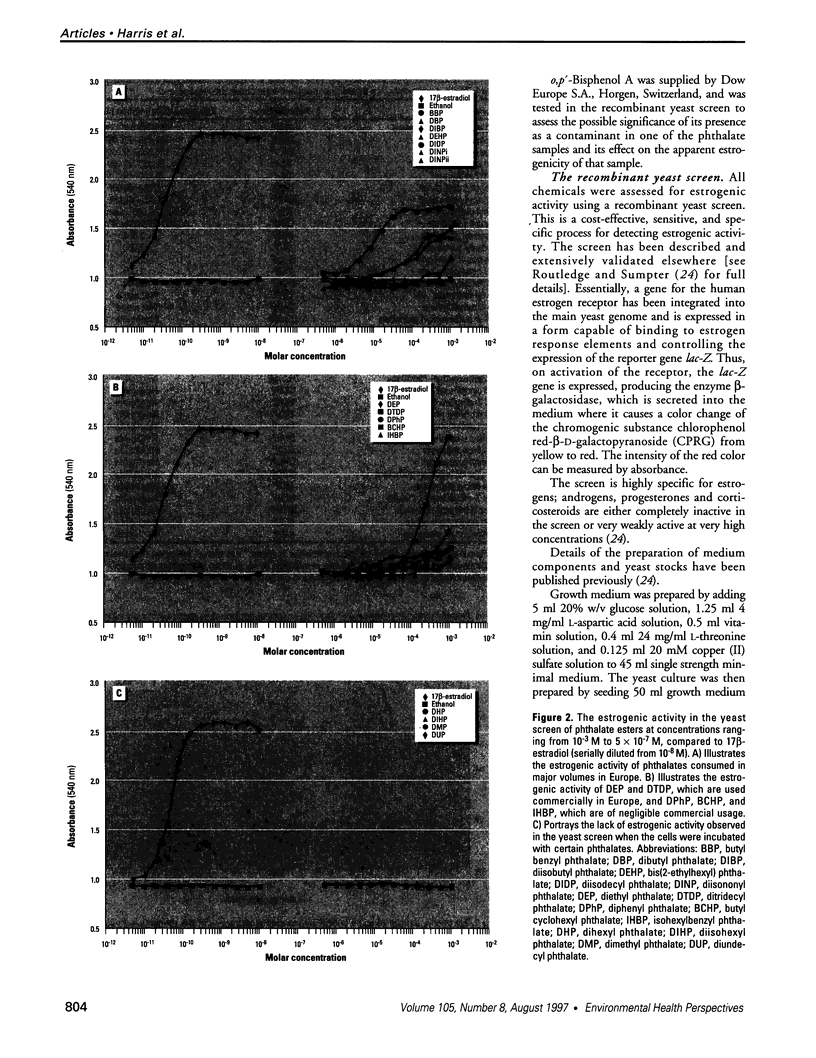
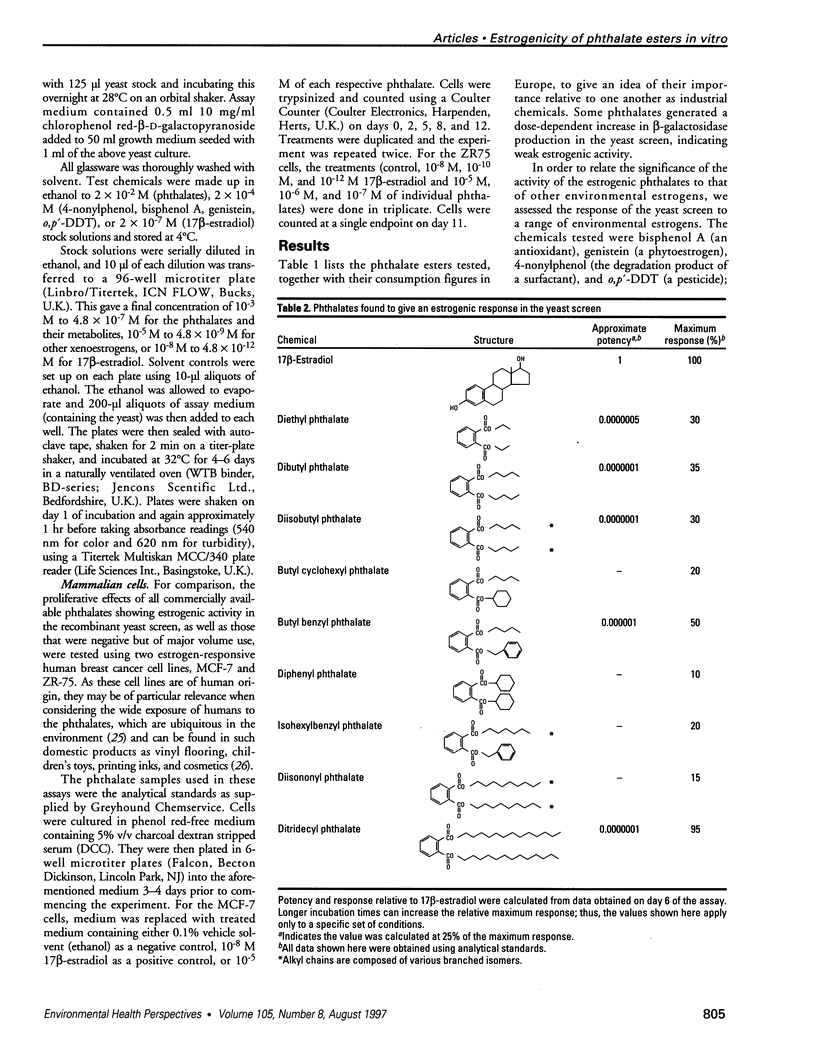
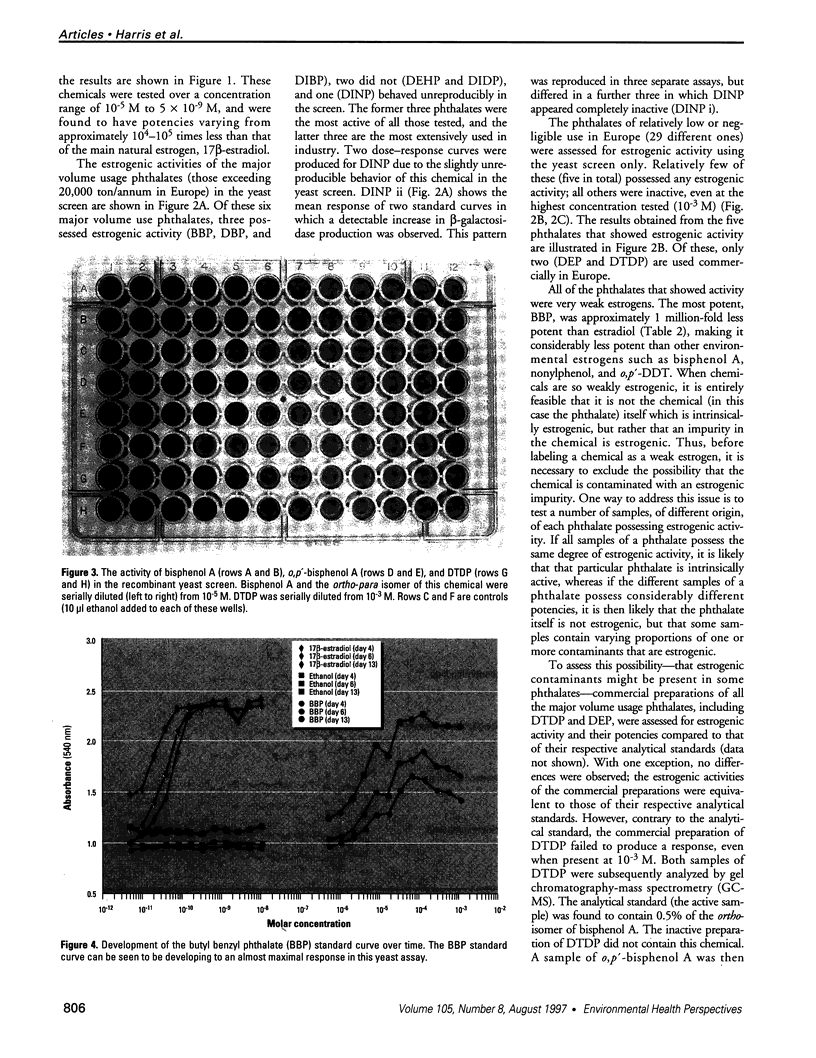
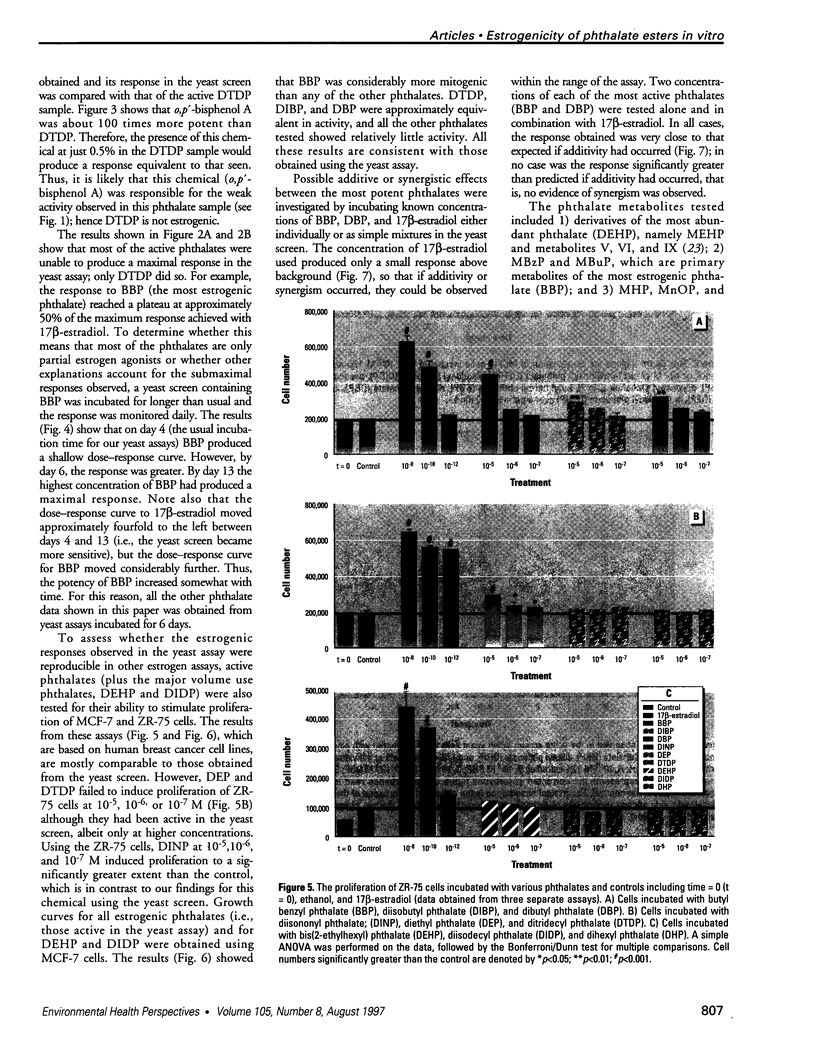
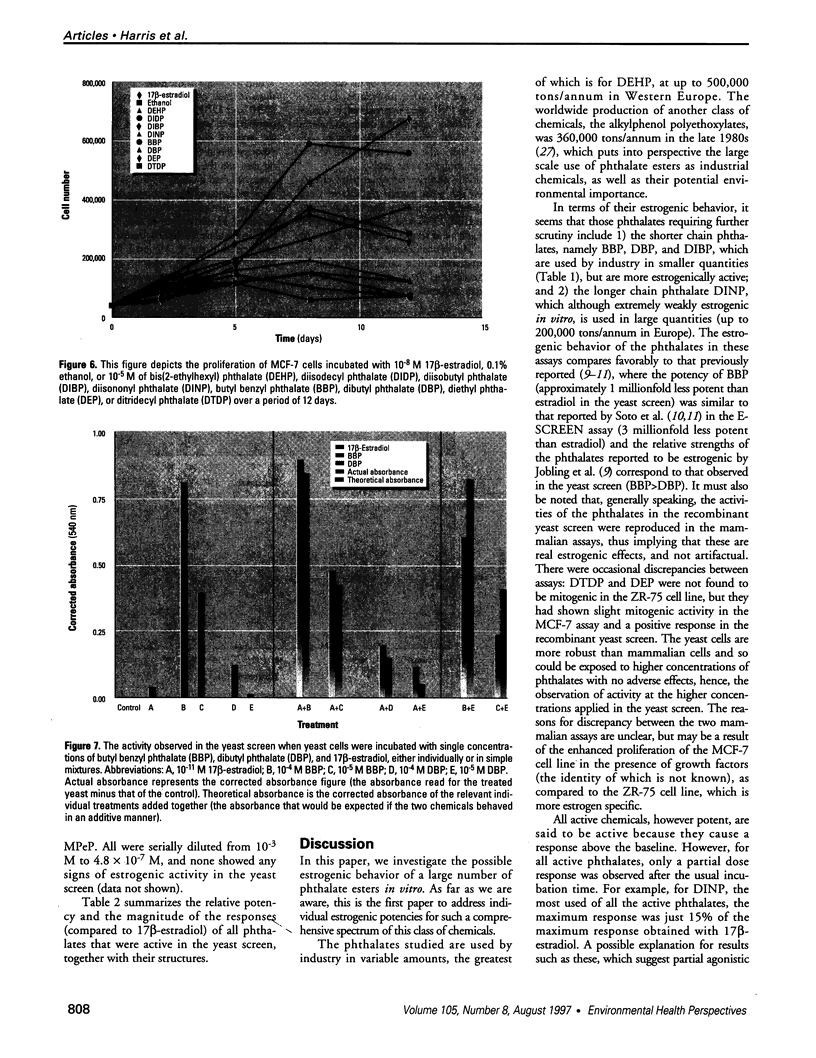
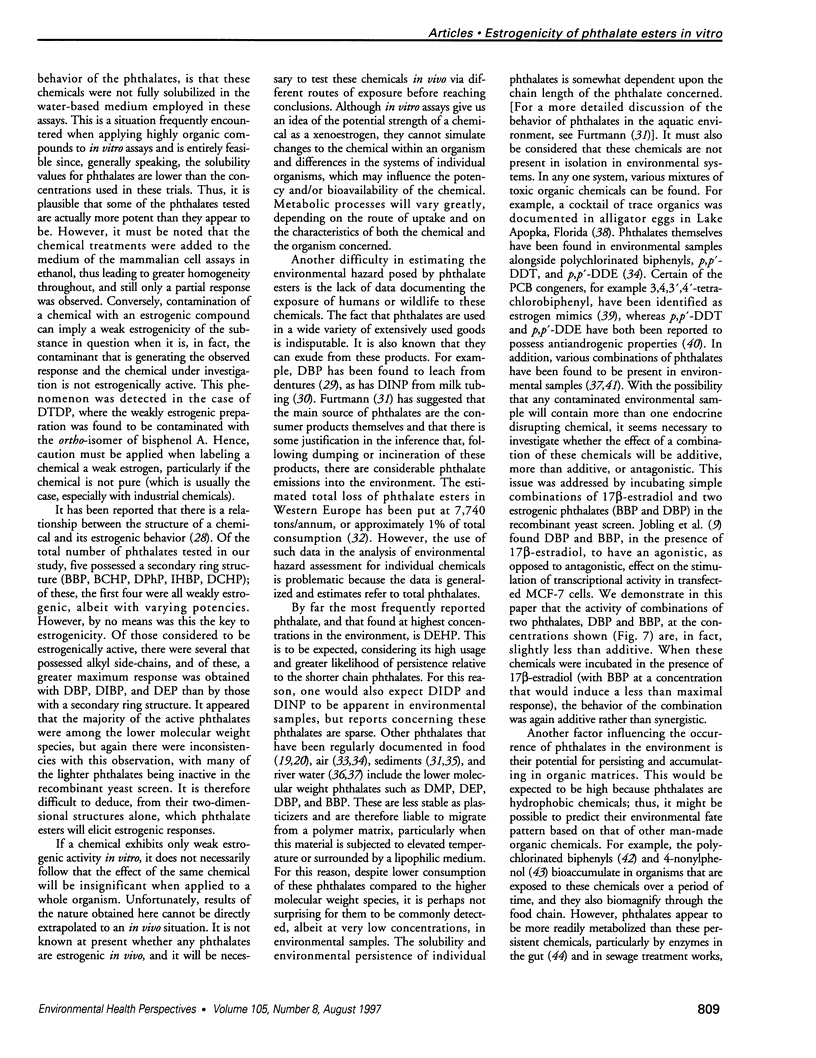
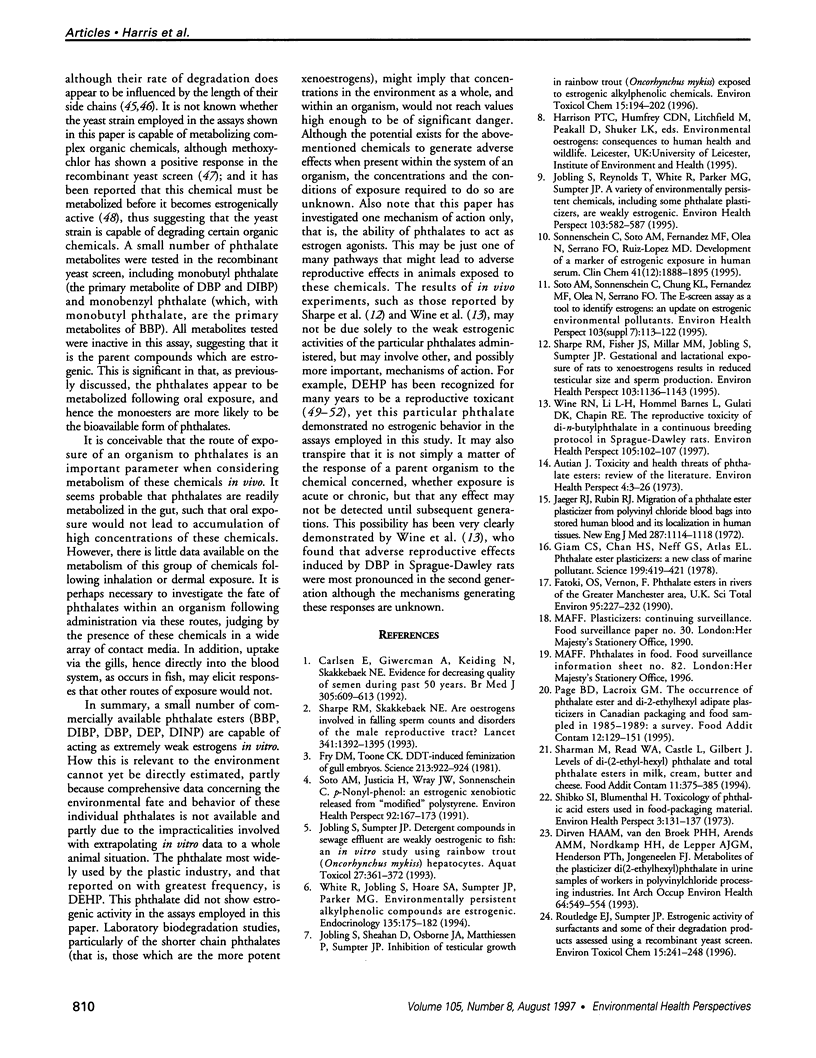
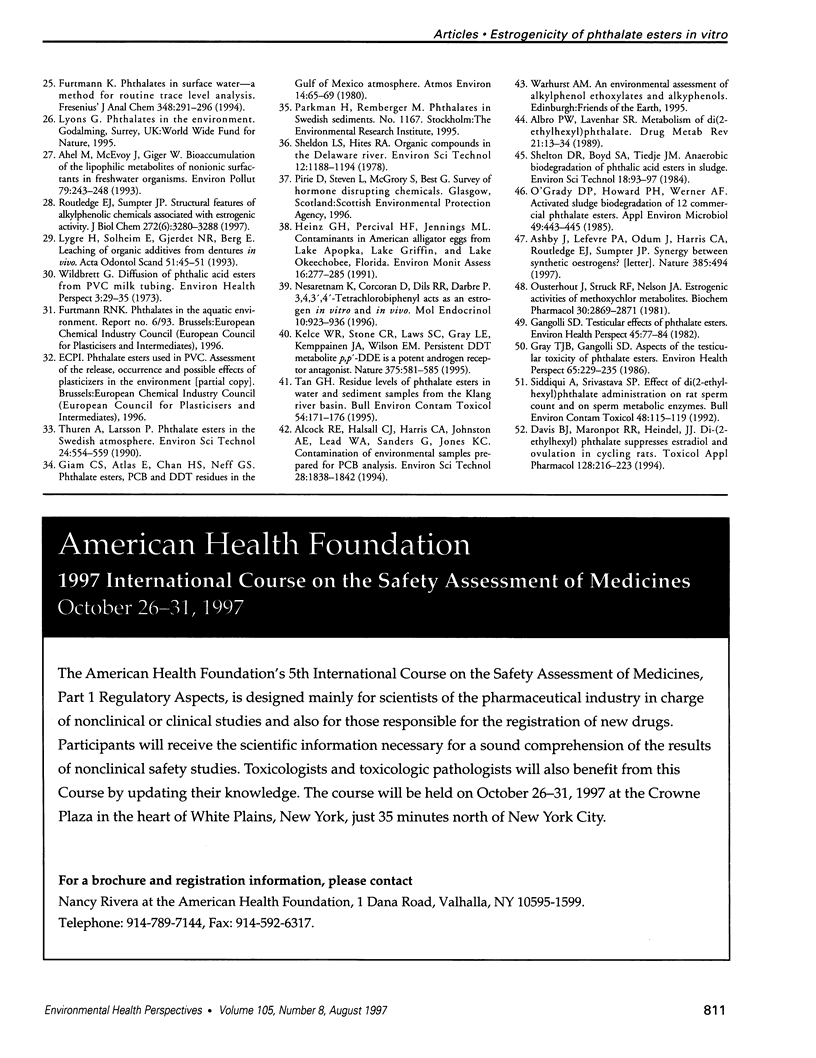
Images in this article
Selected References
These references are in PubMed. This may not be the complete list of references from this article.
- Ahel M., McEvoy J., Giger W. Bioaccumulation of the lipophilic metabolites of nonionic surfactants in freshwater organisms. Environ Pollut. 1993;79(3):243–248. doi: 10.1016/0269-7491(93)90096-7. [DOI] [PubMed] [Google Scholar]
- Albro P. W., Lavenhar S. R. Metabolism of di(2-ethylhexyl)phthalate. Drug Metab Rev. 1989;21(1):13–34. doi: 10.3109/03602538909029953. [DOI] [PubMed] [Google Scholar]
- Ashby J., Lefevre P. A., Odum J., Harris C. A., Routledge E. J., Sumpter J. P. Synergy between synthetic oestrogens? Nature. 1997 Feb 6;385(6616):494–494. doi: 10.1038/385494a0. [DOI] [PubMed] [Google Scholar]
- Autian J. Toxicity and health threats of phthalate esters: review of the literature. Environ Health Perspect. 1973 Jun;4:3–26. doi: 10.1289/ehp.73043. [DOI] [PMC free article] [PubMed] [Google Scholar]
- Carlsen E., Giwercman A., Keiding N., Skakkebaek N. E. Evidence for decreasing quality of semen during past 50 years. BMJ. 1992 Sep 12;305(6854):609–613. doi: 10.1136/bmj.305.6854.609. [DOI] [PMC free article] [PubMed] [Google Scholar]
- Davis B. J., Maronpot R. R., Heindel J. J. Di-(2-ethylhexyl) phthalate suppresses estradiol and ovulation in cycling rats. Toxicol Appl Pharmacol. 1994 Oct;128(2):216–223. doi: 10.1006/taap.1994.1200. [DOI] [PubMed] [Google Scholar]
- Dirven H. A., van den Broek P. H., Arends A. M., Nordkamp H. H., de Lepper A. J., Henderson P. T., Jongeneelen F. J. Metabolites of the plasticizer di(2-ethylhexyl)phthalate in urine samples of workers in polyvinylchloride processing industries. Int Arch Occup Environ Health. 1993;64(8):549–554. doi: 10.1007/BF00517699. [DOI] [PubMed] [Google Scholar]
- Fry D. M., Toone C. K. DDT-induced feminization of gull embryos. Science. 1981 Aug 21;213(4510):922–924. doi: 10.1126/science.7256288. [DOI] [PubMed] [Google Scholar]
- Gangolli S. D. Testicular effects of phthalate esters. Environ Health Perspect. 1982 Nov;45:77–84. doi: 10.1289/ehp.824577. [DOI] [PMC free article] [PubMed] [Google Scholar]
- Giam C. S., Chan H. S., Neff G. S., Atlas E. L. Phthalate ester plasticizers: a new class of marine pollutant. Science. 1978 Jan 27;199(4327):419–421. [PubMed] [Google Scholar]
- Gray T. J., Gangolli S. D. Aspects of the testicular toxicity of phthalate esters. Environ Health Perspect. 1986 Mar;65:229–235. doi: 10.1289/ehp.8665229. [DOI] [PMC free article] [PubMed] [Google Scholar]
- Jaeger R. J., Rubin R. J. Migration of a phthalate ester plasticizer from polyvinyl chloride blood bags into stored human blood and its localization in human tissues. N Engl J Med. 1972 Nov 30;287(22):1114–1118. doi: 10.1056/NEJM197211302872203. [DOI] [PubMed] [Google Scholar]
- Jobling S., Reynolds T., White R., Parker M. G., Sumpter J. P. A variety of environmentally persistent chemicals, including some phthalate plasticizers, are weakly estrogenic. Environ Health Perspect. 1995 Jun;103(6):582–587. doi: 10.1289/ehp.95103582. [DOI] [PMC free article] [PubMed] [Google Scholar]
- Kelce W. R., Stone C. R., Laws S. C., Gray L. E., Kemppainen J. A., Wilson E. M. Persistent DDT metabolite p,p'-DDE is a potent androgen receptor antagonist. Nature. 1995 Jun 15;375(6532):581–585. doi: 10.1038/375581a0. [DOI] [PubMed] [Google Scholar]
- Kuz'min A. I., Selivanov V. N., Anisimov S. P., Sysoev A. B., Medvedev O. S. Mikrodializnoe issledovanie sekretsii katekholaminov v nadpochechnike krysy pri gipovoliumicheskoi gipotenzii. Fiziol Zh SSSR Im I M Sechenova. 1990 Feb;76(2):227–232. [PubMed] [Google Scholar]
- Lygre H., Solheim E., Gjerdet N. R., Berg E. Leaching of organic additives from dentures in vivo. Acta Odontol Scand. 1993 Feb;51(1):45–51. doi: 10.3109/00016359309041147. [DOI] [PubMed] [Google Scholar]
- Nesaretnam K., Corcoran D., Dils R. R., Darbre P. 3,4,3',4'-Tetrachlorobiphenyl acts as an estrogen in vitro and in vivo. Mol Endocrinol. 1996 Aug;10(8):923–936. doi: 10.1210/mend.10.8.8843409. [DOI] [PubMed] [Google Scholar]
- O'grady D. P., Howard P. H., Werner A. F. Activated sludge biodegradation of 12 commercial phthalate esters. Appl Environ Microbiol. 1985 Feb;49(2):443–445. doi: 10.1128/aem.49.2.443-445.1985. [DOI] [PMC free article] [PubMed] [Google Scholar]
- Ousterhout J., Struck R. F., Nelson J. A. Estrogenic activities on methoxychlor metabolites. Biochem Pharmacol. 1981 Oct;30(20):2869–2871. doi: 10.1016/0006-2952(81)90429-9. [DOI] [PubMed] [Google Scholar]
- Page B. D., Lacroix G. M. The occurrence of phthalate ester and di-2-ethylhexyl adipate plasticizers in Canadian packaging and food sampled in 1985-1989: a survey. Food Addit Contam. 1995 Jan-Feb;12(1):129–151. doi: 10.1080/02652039509374287. [DOI] [PubMed] [Google Scholar]
- Routledge E. J., Sumpter J. P. Structural features of alkylphenolic chemicals associated with estrogenic activity. J Biol Chem. 1997 Feb 7;272(6):3280–3288. doi: 10.1074/jbc.272.6.3280. [DOI] [PubMed] [Google Scholar]
- Sharman M., Read W. A., Castle L., Gilbert J. Levels of di-(2-ethylhexyl)phthalate and total phthalate esters in milk, cream, butter and cheese. Food Addit Contam. 1994 May-Jun;11(3):375–385. doi: 10.1080/02652039409374236. [DOI] [PubMed] [Google Scholar]
- Sharpe R. M., Fisher J. S., Millar M. M., Jobling S., Sumpter J. P. Gestational and lactational exposure of rats to xenoestrogens results in reduced testicular size and sperm production. Environ Health Perspect. 1995 Dec;103(12):1136–1143. doi: 10.1289/ehp.951031136. [DOI] [PMC free article] [PubMed] [Google Scholar]
- Sharpe R. M., Skakkebaek N. E. Are oestrogens involved in falling sperm counts and disorders of the male reproductive tract? Lancet. 1993 May 29;341(8857):1392–1395. doi: 10.1016/0140-6736(93)90953-e. [DOI] [PubMed] [Google Scholar]
- Shibko S. I., Blumenthal H. Toxicology of phthalic acid esters used in food-packaging material. Environ Health Perspect. 1973 Jan;3:131–137. doi: 10.1289/ehp.7303131. [DOI] [PMC free article] [PubMed] [Google Scholar]
- Siddiqui A., Srivastava S. P. Effect of di(2-ethylhexyl)phthalate administration on rat sperm count and on sperm metabolic enzymes. Bull Environ Contam Toxicol. 1992 Jan;48(1):115–119. doi: 10.1007/BF00197492. [DOI] [PubMed] [Google Scholar]
- Sonnenschein C., Soto A. M., Fernandez M. F., Olea N., Olea-Serrano M. F., Ruiz-Lopez M. D. Development of a marker of estrogenic exposure in human serum. Clin Chem. 1995 Dec;41(12 Pt 2):1888–1895. [PubMed] [Google Scholar]
- Soto A. M., Justicia H., Wray J. W., Sonnenschein C. p-Nonyl-phenol: an estrogenic xenobiotic released from "modified" polystyrene. Environ Health Perspect. 1991 May;92:167–173. doi: 10.1289/ehp.9192167. [DOI] [PMC free article] [PubMed] [Google Scholar]
- Soto A. M., Sonnenschein C., Chung K. L., Fernandez M. F., Olea N., Serrano F. O. The E-SCREEN assay as a tool to identify estrogens: an update on estrogenic environmental pollutants. Environ Health Perspect. 1995 Oct;103 (Suppl 7):113–122. doi: 10.1289/ehp.95103s7113. [DOI] [PMC free article] [PubMed] [Google Scholar]
- Tan G. H. Residue levels of phthalate esters in water and sediment samples from the Klang River basin. Bull Environ Contam Toxicol. 1995 Feb;54(2):171–176. doi: 10.1007/BF00197427. [DOI] [PubMed] [Google Scholar]
- White R., Jobling S., Hoare S. A., Sumpter J. P., Parker M. G. Environmentally persistent alkylphenolic compounds are estrogenic. Endocrinology. 1994 Jul;135(1):175–182. doi: 10.1210/endo.135.1.8013351. [DOI] [PubMed] [Google Scholar]
- Wildbrett G. Diffusion of phthalic acid esters from PVC milk tubing. Environ Health Perspect. 1973 Jan;3:29–35. doi: 10.1289/ehp.730329. [DOI] [PMC free article] [PubMed] [Google Scholar]
- Wine R. N., Li L. H., Barnes L. H., Gulati D. K., Chapin R. E. Reproductive toxicity of di-n-butylphthalate in a continuous breeding protocol in Sprague-Dawley rats. Environ Health Perspect. 1997 Jan;105(1):102–107. doi: 10.1289/ehp.97105102. [DOI] [PMC free article] [PubMed] [Google Scholar]














